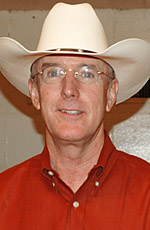 I recently talked with Frank Merrill (pictured), president of the American Quarter Horse Association, about the test that is now available to identify carriers of HERDA (hereditary equine regional dermal asthenia) and the test’s implications for Quarter Horse owners. Merrill has bred and campaigned champion Quarter Horse performers for 40 years, including cutting horses, those most significantly affected by HERDA.
I recently talked with Frank Merrill (pictured), president of the American Quarter Horse Association, about the test that is now available to identify carriers of HERDA (hereditary equine regional dermal asthenia) and the test’s implications for Quarter Horse owners. Merrill has bred and campaigned champion Quarter Horse performers for 40 years, including cutting horses, those most significantly affected by HERDA.
Q: Do you anticipate action being taken by AQHA in regard to HERDA carriers?
A: If there is anything done about it, it is up to the Stud Book and Registration Committee. The Executive Committee does not have auspices over the Stud Book and Registration Committee, when it comes to rules and regulations in regard to registration. If they elect to do anything, as far as designate it as an undesirable disease or trait, that remains to be seen.
I do think that we ought to let people know that we’re not shooting in the dark here. We need to make the public aware that there is a test (to indentify carriers) and that is one hundred percent accurate. But at this juncture, it is dangerous for someone in my position to try to dictate something to members of AQHA. Certainly it’s the breeders’ decision, and it’s another tool that they can use to help them make decisions.
Q: What are your own thoughts as a breeder?
A: It would be meaningful to know whether a horse was a carrier so that you could breed away from (HERDA). But it would also be meaningful to know whether or not a horse is afflicted. That test is yet to come.
There is not a person in the world that wants one of these horses, and it is devastating to know that you’ve bred one or own one. Unfortunately, I bred a filly that had HERDA some years ago. We donated her for research.
It happens too often. But once is too often, really.
As we keep inbreeding to a certain lineage of horses, things like this are going to come up from time to time. I’d like to see a little more out-crossing being done to try to breed away from some of these recessive characteristics that crop up, when you double or triple up on them.
I don’t want to stand on a soapbox and start lecturing, but we have some (outcross) bloodlines in the Quarter Horse industry that are available to us now, rather than go outside our own breed. But people just have to put some thought into it.
This may be the tip of the iceberg. There are probably other characteristics that will crop up in the future that are undesirable. But as we find out about them and develop tests, I think we ought to use those tools to at least make conscionable decisions on our matings.
